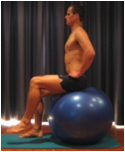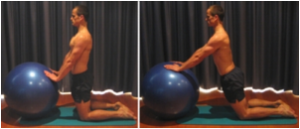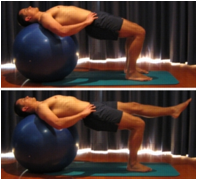
The Importance of Core Stability for Marathon Runners
Runners used to think that with only increasing your time spent running would be the only way to improve your running skills and performance. However runners have soon realised that it is just as important to incorporate core stability and strength training exercises into a programme.
Whether your goal is to run faster, longer or to prevent injuries you will greatly benefit from a structured core stability programme.
What is Core Stability?
Core training can be different things to different people. For runners, the deep core muscles around the spine and pelvis provide a solid base of support from which powerful movements of the limbs can be generated. The bottom line is that any effective core programme must be specific to the athlete’s chosen sport and to the athlete as an individual. A specialist sports physiotherapist is the ideal source for such a programme.
The Benefits of a Stable Core
Training the core effectively results in an increase in your strength, stability and mobility. It can also correct postural imbalances that are associated with injuries. These exercises will improve coordination between your smaller muscles (e.g. pelvic floor muscles) and larger muscles (e.g. pectorals and abdominals). As these muscles become stronger you will more supported and controlled whilst running.
Runners used to think that with only increasing your time spent running would be the only way to improve your running skills and performance. However runners have soon realised that it is just as important to incorporate core stability and strength training exercises in your programme. The core strength exercises a marathon runner uses would be slightly different than that of a sprinter. As a marathon runner would do a larger number of sets and reps for each exercise with a light weight, compared to a sprinter who would concentrate more on power and speed by using heavier with fewer sets and reps.
Exercise Techniques
Swiss balls, balance discs, medicine balls, wobble boards and bosu can help make you core workout both fun, stimulating and competitive.
Examples of Exercises:
1) Easy (small deeper stabilizing muscles exercises)
Leg Lifts
Lying on your back with your hands by your side in neutral spine as demonstrated (figure 1).
Maintain activation of your transversus abdominis and pelvic floor muscles throughout the exercise.
Slowly lift one leg and then return to the starting position.
Keep your spine and pelvis completely still and breathe normally. Perform 10 times alternating between legs.
Figure 1 – Leg Lifts
Heel Taps
Lying on your back in neutral spine with your hands by your side and your hips and knees bent to 90 degrees as demonstrated (figure 2). Maintain activation of your transversus abdominis and pelvic floor muscles throughout the exercise. Slowly lower one leg until your heel touches the ground and then return to the starting position. Keep your spine and pelvis completely still and breathe normally. Perform 10 times alternating between legs.
Bridging
Lying on your back in neutral spine as demonstrated (figure 3). Maintain activation of your transversus abdominis and pelvic floor muscles throughout the exercise. Slowly lift your bottom pushing through your feet, until your knees, hips and shoulders are in a straight line and then return to the starting position. Breathe normally. Perform 10 times.

Figure 3 – Bridging
2) Intermediate (larger muscles exercises)
Prone Hold
Lying on your front , propped up on your elbows and toes in neutral spine as demonstrated (figure 1). Maintain activation of your transversus abdominis and pelvic floor muscles throughout the exercise. Try to keep your spine and pelvis still and breathe normally. Hold this position for as long as possible provided it is pain free and you are maintaining good posture. Repeat 3 times.
Four Point Kneeling Arm Raise
four point kneeling as demonstrated in neutral spine (figure 2). Maintain activation of your transversus abdominis and pelvic floor muscles throughout the exercise. Slowly raise one arm and then return to the starting position. Keep your spine, ribs and pelvis still throughout the exercise and breathe normally. Perform 10 times, provided the exercise is pain free, alternating between arms.

Figure 2 – Four Point Kneeling Arm Raise
3) Sitting on a Swiss ball in neutral spine with your feet together (figure 3). Maintain activation of your transversus abdominis and pelvic floor muscles throughout the exercise. Slowly lift one leg slightly off the ground keeping the Swiss ball still and then return to the starting position. Keep your spine and pelvis still throughout the exercise and breathe normally. Perform 10 repetitions, provided the exercise is pain free, alternating legs.

Figure 3 –Swiss Ball Sitting Leg Lifts
3) Advanced (dynamic trunk exercises)
Roll Outs
Kneeling in neutral spine with your hands on a Swiss ball as demonstrated (figure 1). Maintain activation of your transversus abdominis and pelvic floor throughout the exercise. Slowly roll forwards, moving at your knees, keeping your back and arms straight, then return to the start position. Keep your spine and pelvis still throughout the exercise and breathe normally. Perform 10 repetitions provided the exercise is pain free.

Figure 1 – Roll Outs
Swiss Ball Single Leg Bridge
Lying on your back in neutral spine with a Swiss ball under your shoulder blades and your feet slightly apart as demonstrated (figure 2). Maintain activation of your transversus abdominis and pelvic floor throughout the exercise. Keeping your spine and the Swiss ball still, slowly straighten one knee and then return to the starting position. Then, slowly straighten the other knee and then return to the starting position. Perform 10 repetitions provided the exercise is pain free, alternating legs.

Figure 2 – Swiss Ball Single Leg Bridge
Considerations
Make sure you think how appropriate each core exercise is to your training goal. It is also important to pay attention to any pain or discomfort that you experience prior to implementing new exercises or during performance. If core strength exercises are not executed properly, they could hurt rather than help you. A full biomechanical assessment by a Sports Physiotherapist is highly recommended prior to commencing any new programme.
It is important to regularly do Core stability exercises to prevent injury. The rationale for prevention training is that increased recruitment of the stabiliser muscles and increased strength of the main movement muscles will carry over into better posture and more control, both in daily life and in sport.
Most of us tend to have a list of three or four of these exercises that we include in our workouts each week. Which is great as will be prehabilitve however it does have its limitations. As if we do the same exercises for 20-30 mins 3 x week if can become ‘bore’ stability. So the key is to continually challenge your body; progression and variation will optimize the benefits of any programme
In summary it is important to see a physiotherapist at Physio4Life for a thorough assessment that could indentify your weakness and help reduce the risk of injury and improve your performance and to set a program with the correct core stability exercises which are individual for you.






